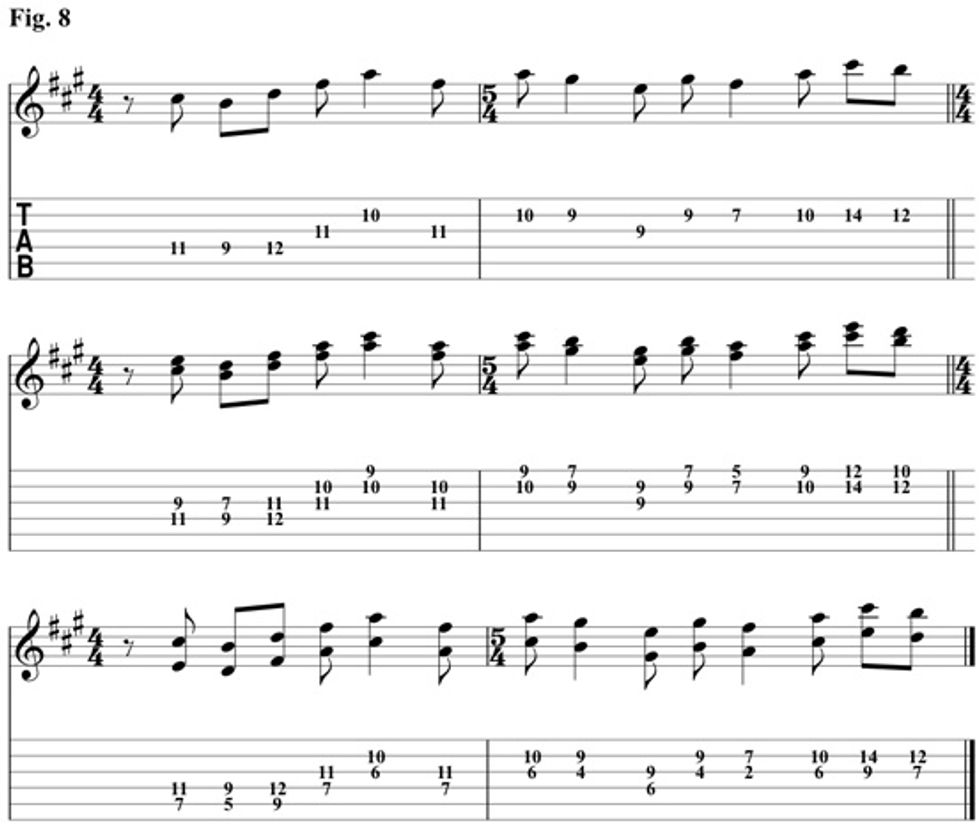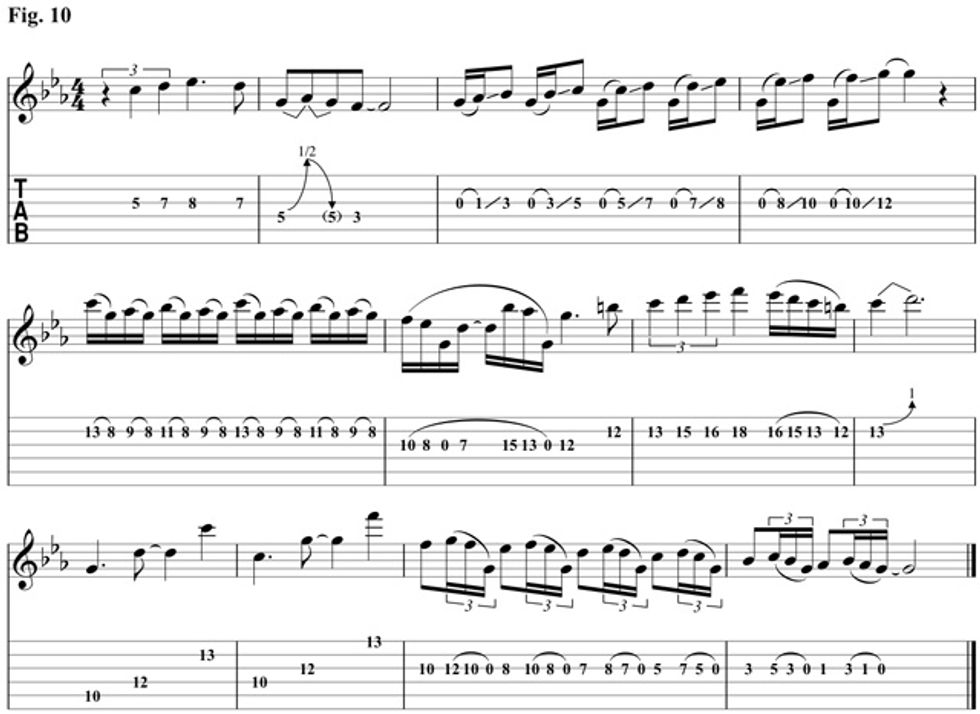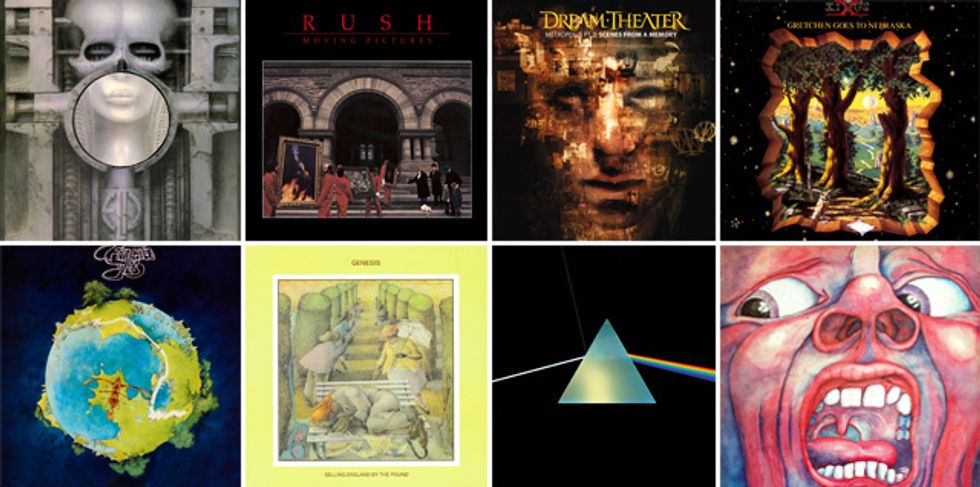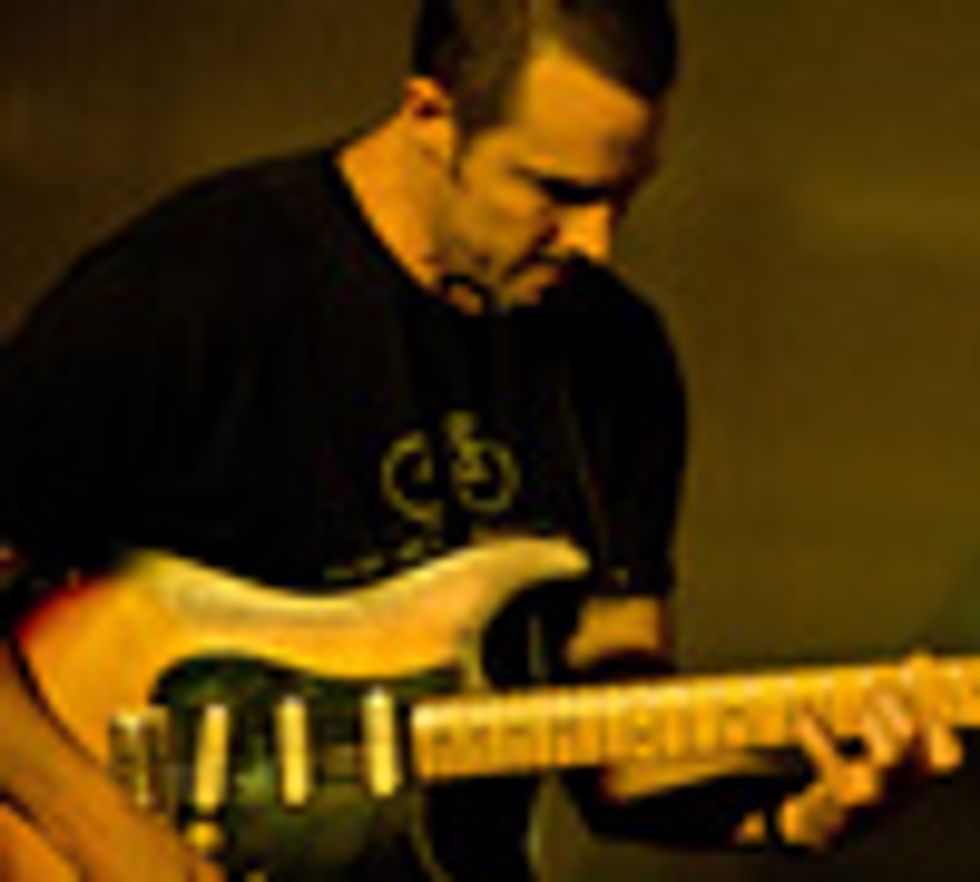Chops: Intermediate
Theory: Intermediate
Lesson Overview:
• Understand the key elements of progressive rock.
• Create and learn phrases using odd time signatures and rhythmic displacement.
• Delve into the styles of Alex Lifeson, Steve Howe, David Gilmour, and other greats.
Click here to download a printable PDF of this lesson's notation.
Put away your cape and grab your axe. No, your other axe.
The progressive rock genre started in the late 1960s as an effort to elevate the artistic credibility of rock music. Extended musical forms, time signatures other than 4/4, and modal harmonies and melodies are some of the musical tools that separate this genre from other styles. Guitarists like Steve Howe (Yes), Alex Lifeson (Rush), David Gilmour (Pink Floyd), Robert Fripp (King Crimson), Ty Tabor (King’s X) and John Petrucci (Dream Theater) used open string voicings, harmonized lines, and time signature shifts to create a more expressive and melodic style of playing.
In this Style Guide, we’ll focus on just a few of the guitar techniques that are at the foundation of progressive rock—open string chords, harmonized lines, time signatures, and soloing style. Once you understand how these pieces work, you can combine and rearrange them to create your own journey to the center of the earth!
Time Signatures
Mixing different time signatures is a prominent aspect of progressive rock. While 4/4 is not completely abandoned, it’s good to get a handle on 5/4, 6/4, and 7/4. The first measure of Fig. 1 is an A minor riff in 4/4, and here we keep it simple by only using scale tones 1, b3, and b7. By changing the last two eighth-notes to quarter-notes, you can make the motif work in 5/4. I used a similar process to morph the original riff into 6/4 and 7/4. By adding notes or changing rhythms, you can adapt any riff to different time signatures.

Once you have a list of riffs, start putting them together in various orders. Every measure could be a new time signature, or you could change only one measure. Fig. 2 is a four-measure phrase using the sequence 6/4–7/4–6/4–5/4. Remember, be progressive! Build a nine-measure phrase in 6/4 or a five-measure phrase in 7/4 … the list goes on.

Expanding on the previous example, Fig. 3 changes the harmony in measures two and four to reflect a Gmaj7 sound. This give the entire phrase a modal, A Dorian (A–B–C–D–E–F#–G) vibe.

It’s also common to see measures of 3/8, 6/8, or 9/8 injected into a quarter-note-based phrase. Fig. 4 uses the original riff and is offset by measure two (a short motif in 3/8) and measure four (an expansion of the 3/8 motif). These can be tricky to play. If you’re used to counting quarter-notes, the time will seem to turn around, especially when moving from measure two to three. Start by making the eighth-note your pulse and practice slowly at first!

Take a listen to “Firth of Fifth” by Genesis or “Starship Trooper” by Yes and notice how many sections, chord progressions, and time signatures the bands used to create each tune. Pretty steep!
Open-String Chord Voicings
Open-string chords are one of the more distinctive elements of this style and are used by many progressive rock guitar players, Alex Lifeson being the most notable. The CAGED system and standard barre chords are still used, but adding open strings and arpeggio patterns can lead you to some new sounds. You can take an existing chord and lift up a finger, move shapes up the neck, or use your knowledge of theory to generate these voicings.
One approach is to start with an existing open-string voicing and move the bass note in half- or whole-steps. Fig. 5 starts with Bmin11 voicing that contains an open 4th and an open 1st string. The bass note then moves up a half-step to C and then down a whole-step to Bb. Keeping the notes the same on the top four strings creates a pedal of sorts—a common thread between each chord.

Fig. 6 takes a different approach in that the entire chord shape is moved around the neck. I started with a trustworthy C major (adding another fifth at the 3rd fret, first string) and moved it up the fretboard to find chords that I liked. This can add extensions and alterations to chords and is an easy way to add a new flavor to stock chord progressions. You should try this with every chord in the CAGED system!

Another voicing technique is to take the full 6-string major barre chord and un-barre it, opening up the top two strings. Fig. 7 uses the same brute-force method, moving the chord shape up and down the neck to find some interesting voicings that have extensions or alterations.

Harmonized Lines
I’ve got two words for you—“Long Distance Runaround” by Yes. All right, that’s three words, but Steve Howe’s harmonized guitar intro is a pretty good lesson in itself on how to harmonize a guitar line. Harmonizing two guitar lines is a crafty way of creating a chord progression without actually playing chords. To harmonize, you need to know scales and intervals (which are pairs of notes). Fig. 8 uses the A major scale (A–B–C#–D–E–F#–G#–A) and the intervals of a third and a sixth.

An interval of a third occurs when you pair every other note in the scale, or a third away (A–C#, B–D, C#–E, etc). Sixths are pairing of notes that are a sixth away (A–F#, B–G#, C#–A, etc.). Notice that when you flip a third upside down, you get a sixth (D–F# is a third and F#–D is a sixth). It’s theory magic!
So, why do we use thirds and sixths but not other intervals? Chords are traditionally built in thirds, so intervals of a third (or sixth) will sound like chords as well. For example, a D major triad has the notes D–F#–A. If you play only D–F#, it will sound like D major. If you play F#–A on you guitar and your bass player plays D, it will still sound like D major—nifty. You can harmonize with other intervals too, but they sound less like a traditional chord. Sometimes that’s good.
Back to Fig. 8: The first line is the melody by itself. The second line is the melody harmonized a third above. The last line is the melody harmonized a sixth below.
Solos
Guitar solos in most types of rock tend to use pentatonic scales and blues-based vocabulary. Bends, hammer-ons, pull-offs, and slides are not foreign to progressive rock guitarists and are used frequently. Combined with modes, sequences, and motifs, these techniques are used to create a more compositional and expressive style of soloing.
Fig. 9 is a Gilmour-esque example that mixes some extended chord tones and triplets with a couple of fairly common guitar bends in E minor. At the end of the first measure, the half-step bend/release on F# brings out the #11 of Cmaj7 and the 9 of Em7. The whole-step bend to B at the beginning of measure 3 (also a regular occurrence in the E minor pentatonic system) is the major seventh of Cmaj7. Also, the rhythmic structure of the phrase creates a “mirror” effect—you move from triplets to bends and longer notes (measure 1 and 2), and then reverse that by moving from bends and longer notes to triplets (measure 3 and 4).

Fig. 10 is inspired by Alex Lifeson’s playing from the early 1980s. This G Phrygian (G–Ab–Bb–C–D–Eb–F) example has three four-measure phrases and is a mash up of a few techniques. There are hammer-ons and pull-offs that incorporate the open 3rd string. When the scale or mode contains an open string note, it’s easy to create ideas using that string (measures 3, 4, 6, 11, and 12). Wider intervals (measures 9 and 10) are a nice way to balance the overall phrasing. They are near the end of the solo and balance out the 16th-notes of the previous phrase.

There are motivic sequences (measures 3 and 4, and measures 11 and 12), repetition (measure 5), half-step bends that emphasize the mode (measures 1 and 2), and even a homage to Mr. Lifeson’s “YYZ” solo (measures 7 and 8).
The topics covered in this style guide will hopefully provide some insight to progressive rock guitar playing. It’s not an exhaustive list of techniques, but will hopefully give you an understanding of what to listen for and an approach for learning and creating songs in this style.

Suggested Discography
King Crimson – In the Court of the Crimson King
Described as the group’s definitive album and one of the most daring debut albums of all time, it crushed the competition and set a new standard for progressive rock with Robert Fripp’s mixture of classical, Hendrix-like rock, and jazz imagery. Check out “21st Century Schizoid Man” and “In the Court of the Crimson King” and you’ll see why.
Yes – Fragile
This album marks the point where all the elements of their music come together, propelling the band from cult status to a worldwide reality. Popular songs from The Yes Album contained sci-fi and fantasy themes and Fragile capitalizes on that momentum, defining the Yes sound for the next decade. “Roundabout,” “Long Distance Runaround,” and “Heart of the Sunrise” are excellent examples of classic Yes.
Emerson, Lake & Palmer – Brain Salad Surgery
This album is ambitious, well realized, electronic, loud, and successful. It represents a high point for the band and is exemplified by the 20-minute “Karn Evil 9” trilogy. Pete Sinfield (King Crimson) helped provide the lyrics that sustain the carnival and fantasy epic. “Karn Evil 9: 1st Impression” and “Still… You Turn Me On” have all the multi-layered masquerade that one will ever need.
Genesis – Selling England By The Pound
Returning to their English eccentricity, Genesis created an album that has a storybook quality to it. It is a rock record that plays as a collection of short stories, but the songs stand up exceptionally well on their own. “Dancing with the Moonlit Knight” and “I Know What I Like” are provided by the classic Tony Banks/Phil Collins/Steve Hackett/Peter Gabriel lineup.
Pink Floyd – The Dark Side of the Moon
Over 1,500 weeks on the Billboard 200 chart and still selling almost 10,000 copies a week. Not too shabby. A collection of songs about mundane, everyday details made psychedelic through soundscapes, tape effects, jazz-rock, and the blues. More commercial than previous Floyd albums, but listen again to “Money,” “Us and Them,” or “Time” for the progressive, blues influenced writing and playing of David Gilmour.
Rush – Moving Pictures
Though successful as a crossover album, Moving Pictures reflects the band’s progressive rock sensibilities in such songs as “YYZ,” “Tom Sawyer,” and “Limelight.” Treat yourself to a listening of “Witch Hunt” and absorb the lyrical imagery, 2/4 measure, odd-numbered phrasing, and multi-sectional riffery of one of the more underrated compositions from this album.
King’s X – Gretchen Goes to Nebraska
On the heavier side of things, this offering from King’s X has been praised for its progressive musical approach and varied styles. Featuring harmonized vocals and woven bass and guitar lines, “Summerland” and “Pleiades” offer the core elements of progressive rock.
Dream Theater – Metropolis, Pt. 2: Scenes from a Memory
Heavier still, this concept album from Dream Theater is an elaborate composition that dives into old-fashioned progressive rock. A close listen will reveal the intricacies of the song structures, which include long instrumental sections offset by the narrative lyrics. “Overture 1928” borrows riffs and other material from “Metropolis, Pt. 1: The Miracle and the Sleeper,” a song from an earlier album called Images and Words, and “Strange Déjà Vu” has it all—complex meters, complex chords, soaring vocals, and riffs aplenty.
 Pete Weise has a B.M. and M.M. in Jazz Studies from the University of North Texas, is an Associate Professor of Jazz Guitar at Collin College, faculty of the National Guitar Workshop, and teaches privately at the Guitar Sanctuary and the Fine Arts Academy at FBC Keller. He leads his own jazz fusion quartet and is a freelance guitarist in Denton/Dallas, Texas. Visit peteweise.com for more information.
Pete Weise has a B.M. and M.M. in Jazz Studies from the University of North Texas, is an Associate Professor of Jazz Guitar at Collin College, faculty of the National Guitar Workshop, and teaches privately at the Guitar Sanctuary and the Fine Arts Academy at FBC Keller. He leads his own jazz fusion quartet and is a freelance guitarist in Denton/Dallas, Texas. Visit peteweise.com for more information.











![Rig Rundown: Russian Circles’ Mike Sullivan [2025]](https://www.premierguitar.com/media-library/youtube.jpg?id=62303631&width=1245&height=700&quality=70&coordinates=0%2C0%2C0%2C0)





